Apodiformes are one of the most diverse orders of migratory birds on Earth. There are almost 450 species so far identified within three living familes: swifts, tree swifts and hummingbirds. The name Apodiformes is based on the Greek words "a pous," meaning "without foot." Apodiforms have small feet and their legs are short. Many birds in this order cannot walk, and they are unable to escape quickly by simply walking and then flying away if they land on the ground.
Although their feet are weak, apodiforms are strong fliers because they have thick shoulder bones and long, powerful breastbones. Because of their neck muscles, these birds can move their heads quickly. Long wings containing short bones allow for some spectacular flying and hovering.
In Southern Africa, there are only birds of the family Apodiae (swifts).
The swifts are a family, Apodidae, of highly aerial birds. They are superficially similar to swallows, but are not closely related to passerine species.
Swifts are the most aerial of birds. Larger species are amongst the fastest fliers in the animal kingdom. The Common Swift can cruise at a maximum speed of 31 metres per second (112 km/h). In a single year the common swift can cover at least 200,000 km.
Compared with typical birds, swiftlet wings have proportionately large wingtip bones. By changing the angle between the wingtip bones and the forelimb bones, they are able to alter the shape and area of their wings, maximizing their efficiency and maneuverability at various speeds. They are able to rotate their wings from the base, a trait that allows the wing to remain rigid and fully extended deriving power on both upstroke and downstroke. The downstrokes produces both lift and thrust, while the upstrokes produces a negative thrust (drag) that is 60% of the thrust generated during the downstrokes, but simultaneously it contributes with a lift that is also 60% of what is produced during the downstroke. This flight arrangement could also have benefits for the bird's control and maneuverability in the air.
Swifts occur on all the continents, though not in the far north or large deserts. The swifts of temperate regions are strongly migratory and winter in the tropics.
Africa Wild Bird Book
Family Apodidae (Swifts) Index
ORDER APODIFORMES
Family Apodidae (Swifts)
Schoutedenapus myoptilus Scarce Swift 420
Telacanthura ussheri Mottled Spinetail 422
Neafrapus boehmi Bat-like Spinetail (Böhm's Spinetail) 423
Cypsiurus parvus African Palm-Swift 421
Tachymarptis melba Alpine Swift 418
Tachymarptis aequatorialis Mottled Swift 419
Apus apus Common Swift 411
Apus pallidus Pallid Swift 414
Apus barbatus African Black Swift 412
Apus bradfieldi Bradfield's Swift 413
Apus affinis Little Swift 417
Apus horus Horus Swift 416
Apus caffer White-rumped Swift 415
Family Apodidae (Swifts)
Schoutedenapus myoptilus Scarce Swift 420
Telacanthura ussheri Mottled Spinetail 422
Neafrapus boehmi Bat-like Spinetail (Böhm's Spinetail) 423
Cypsiurus parvus African Palm-Swift 421
Tachymarptis melba Alpine Swift 418
Tachymarptis aequatorialis Mottled Swift 419
Apus apus Common Swift 411
Apus pallidus Pallid Swift 414
Apus barbatus African Black Swift 412
Apus bradfieldi Bradfield's Swift 413
Apus affinis Little Swift 417
Apus horus Horus Swift 416
Apus caffer White-rumped Swift 415
Mottled Spinetail
422. Mottled Spinetail Telacanthura ussheri (Gevlekte Stekelstert)
Order: Apodiformes. Family: Apodidae
Description
With 14 cm a medium-sized, typical Spinetail. All dark except for mottled white throat patch and pure white rump which extends around the flanks onto the underparts. Dark brown, extensive grey-white mottling on chin and throat patch. Wings and tail are glossed blue. Short square tail, looking rounded when spread. Spinetail winge shape: hooked in outer wing and bulging in midwing.
Similar species: Told from Little Swift by the white throat extending onto the upper breast, where it appears mottled, and in having a small, white patch on the undertail coverts.
Distribution
The Mottled Spinetail is widely but discontinuously distributed throughout tropical Africa from Limpopo to Senegal. In southern Africa it is scarce and localised, occurring in northern and south-eastern Zimbabwe, Mozambique and north-eastern Limpopo Province.
Habitat
It mainly forages over dense woodland, such as miombo (Brachystegia) woodland, or evergreen and riverine forest.In southern Africa the principal habitat is hot, low-lying valleys in Mopane veld in which Baobabs are common.
Diet
Winged ants, flies, termites and Hymenoptera.
Breeding
Monogamous; usually breeds in colonies of about 2-5 breeding pairs, however it does occasionally nest solitarily. The nest is a saucer-shaped bowl, built of a wide variety of materials, such as feathers, twigs, bark and sand, all glued together with saliva. It is almost invariably placed in a cavity in a Baobab (Adansonia digitata) tree, however in other parts of Africa it also nests in buildings and crevices. Egg-laying season is mainly from November-March. It lays 1-2 eggs.
Call
Very high, dry tchu-tchu tchnrchrrr or various twittering calls; mostly silent. Listen to Bird Call.
Status
Uncommon. Highly localised resident to preferred habitat.
Order: Apodiformes. Family: Apodidae
Description
With 14 cm a medium-sized, typical Spinetail. All dark except for mottled white throat patch and pure white rump which extends around the flanks onto the underparts. Dark brown, extensive grey-white mottling on chin and throat patch. Wings and tail are glossed blue. Short square tail, looking rounded when spread. Spinetail winge shape: hooked in outer wing and bulging in midwing.
Similar species: Told from Little Swift by the white throat extending onto the upper breast, where it appears mottled, and in having a small, white patch on the undertail coverts.
Distribution
The Mottled Spinetail is widely but discontinuously distributed throughout tropical Africa from Limpopo to Senegal. In southern Africa it is scarce and localised, occurring in northern and south-eastern Zimbabwe, Mozambique and north-eastern Limpopo Province.
Habitat
It mainly forages over dense woodland, such as miombo (Brachystegia) woodland, or evergreen and riverine forest.In southern Africa the principal habitat is hot, low-lying valleys in Mopane veld in which Baobabs are common.
Diet
Winged ants, flies, termites and Hymenoptera.
Breeding
Monogamous; usually breeds in colonies of about 2-5 breeding pairs, however it does occasionally nest solitarily. The nest is a saucer-shaped bowl, built of a wide variety of materials, such as feathers, twigs, bark and sand, all glued together with saliva. It is almost invariably placed in a cavity in a Baobab (Adansonia digitata) tree, however in other parts of Africa it also nests in buildings and crevices. Egg-laying season is mainly from November-March. It lays 1-2 eggs.
Call
Very high, dry tchu-tchu tchnrchrrr or various twittering calls; mostly silent. Listen to Bird Call.
Status
Uncommon. Highly localised resident to preferred habitat.
Dewi
What is the good of having a nice house without a decent planet to put it on? (H D Thoreau)
What is the good of having a nice house without a decent planet to put it on? (H D Thoreau)
Mottled Spinetail Photos
422. Mottled Spinetail Telacanthura ussheri (Gevlekte Stekelstert)
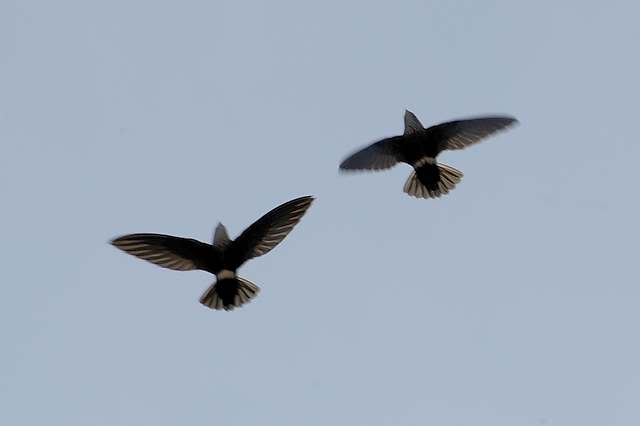
Links:
Species text Sabap1
Sabap2

Links:
Species text Sabap1
Sabap2
Dewi
What is the good of having a nice house without a decent planet to put it on? (H D Thoreau)
What is the good of having a nice house without a decent planet to put it on? (H D Thoreau)
African Palm Swift
421. African Palm Swift Cypsiurus parvus
Order: Apodiformes. Family: Apodidae
Description
The most slender, long-tailed swift. Length 14-17 cm; very slender, uniform brownish grey; tail very long, pointed, deeply forked; wings long swept-back, slender, pointed, very short legs which they use only for clinging to vertical surfaces. Iris dark brown; bill black.
Juvenile: Scaled with rufous buff above and below; tail shorter than that of adult.
Distribution
Africa South of Sahara, Madagascar; in South Africa mainly in N and E; spreading westwards to SW Gauteng, N Cape (Kuruman) and S Namibia (Mariental, Auob River).
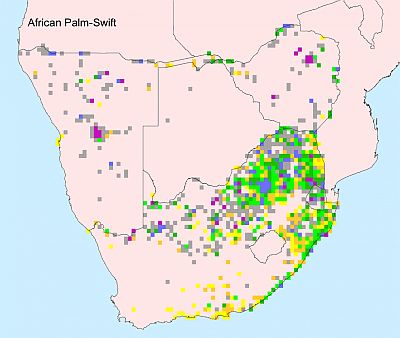
Habitat
Palms in woodland, parks, cities.
Diet
Aerial arthropods, including termite alates. It often forages in flocks, usually with other swift and swallow species.
Breeding
Monogamous, solitary or colonial nester. It usually lives in colonies of up to 100 breeding pairs, but it may occasionally nest solitarily. Both sexes build the nest, which is a shallow cup of feathers and plant detritus, glued together with saliva. It is usually placed on the upper side of a palm frond, which is usually a Borassus palm (Borassus aethiopum), Lala palm (Hyphaene coriacea), Northern Lala palm (Hyphaene petersiana), or the alien genera Livistona and Washingtonia. It may also place the nest in a building or steel bridge. Egg-laying season is year-round, peaking from August-November. It lays usually 2 white eggs, which the female immediately glues to the nest using her own saliva. The eggs are then incubated by both sexes for 18-22 days. The chicks are brooded and fed by both sexes, leaving the nest and becoming independent when they are about 29-33 days old.
Call
High-pitched thin querulous scream; faint tseep.
Status
Locally common resident; numbers increasing because of artificial planting of palm trees and increasing use of manmade structures for nesting.
Order: Apodiformes. Family: Apodidae
Description
The most slender, long-tailed swift. Length 14-17 cm; very slender, uniform brownish grey; tail very long, pointed, deeply forked; wings long swept-back, slender, pointed, very short legs which they use only for clinging to vertical surfaces. Iris dark brown; bill black.
Juvenile: Scaled with rufous buff above and below; tail shorter than that of adult.
Distribution
Africa South of Sahara, Madagascar; in South Africa mainly in N and E; spreading westwards to SW Gauteng, N Cape (Kuruman) and S Namibia (Mariental, Auob River).

Habitat
Palms in woodland, parks, cities.
Diet
Aerial arthropods, including termite alates. It often forages in flocks, usually with other swift and swallow species.
Breeding
Monogamous, solitary or colonial nester. It usually lives in colonies of up to 100 breeding pairs, but it may occasionally nest solitarily. Both sexes build the nest, which is a shallow cup of feathers and plant detritus, glued together with saliva. It is usually placed on the upper side of a palm frond, which is usually a Borassus palm (Borassus aethiopum), Lala palm (Hyphaene coriacea), Northern Lala palm (Hyphaene petersiana), or the alien genera Livistona and Washingtonia. It may also place the nest in a building or steel bridge. Egg-laying season is year-round, peaking from August-November. It lays usually 2 white eggs, which the female immediately glues to the nest using her own saliva. The eggs are then incubated by both sexes for 18-22 days. The chicks are brooded and fed by both sexes, leaving the nest and becoming independent when they are about 29-33 days old.
Call
High-pitched thin querulous scream; faint tseep.
Status
Locally common resident; numbers increasing because of artificial planting of palm trees and increasing use of manmade structures for nesting.
African Palm Swift Photos
421. African Palm Swift Cypsiurus parvus
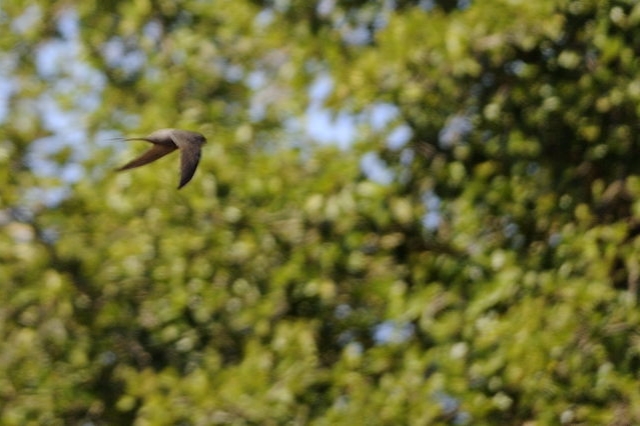 © Dewi
© Dewi
Babalala, Kruger National Park
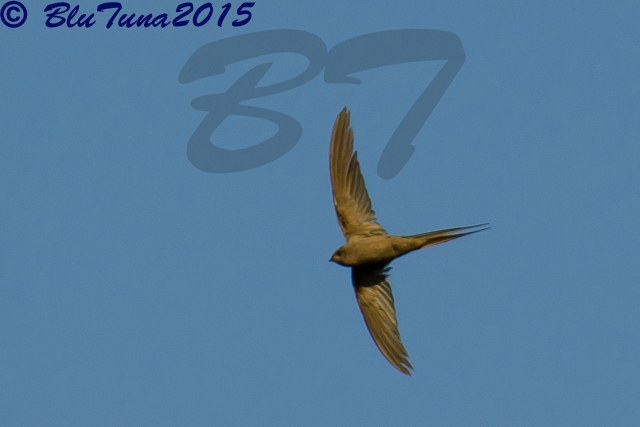 © BluTuna
© BluTuna
Northern Farm, Johannesburg
Links:
Sabap2
Species Text Sabap1: http://sabap2.adu.org.za/docs/sabap1/421.pdf
Birds of Botswana
SASOL VOELS VAN SUIDER AFRICA (3de UIT)
NEWMAN'S VOELS VAN SA (8ste UIT)
 © Dewi
© DewiBabalala, Kruger National Park
 © BluTuna
© BluTunaNorthern Farm, Johannesburg
Links:
Sabap2
Species Text Sabap1: http://sabap2.adu.org.za/docs/sabap1/421.pdf
Birds of Botswana
SASOL VOELS VAN SUIDER AFRICA (3de UIT)
NEWMAN'S VOELS VAN SA (8ste UIT)
Alpine Swift
418. Alpine Swift Tachymarptis melba (Witpenswindswael)
Order: Apodiformes. Family: Apodidae
Description
21-22 cm. A very large, fast-flying swift and the only one to show white underparts and a dark breast band. Very short legs. Head brown with a dark eye patch. All black with white belly and throat. Dark grey brown neck band separates the white areas. Short forked tail. Very long swept-back wings that resemble a crescent. Sexes alike. It is often seen in mixed flocks with other swift species.
The juvenile is similar to the adult, but the feathers are pale edged.
Distribution
Patchily distributed across sub-Saharan Africa, from Ethiopia south to southern Africa. Within southern Africa it occurs in Namibia, eastern Botswana, northern and southern Zimbabwe, western Mozambique, Swaziland, Lesotho and South Africa.
Habitat
Breeds in mountainous areas, but it can forage over almost any habitat, generally preferring alpine grassland and fynbos.
Movements and Migrations
Partial intra-African breeding migrant, as it has a resident population in Namibia and a migratory population in the rest of southern Africa. This population arrives here around August, going through its full breeding cycle before leaving around May, although some individuals stay here throughout the winter.
Diet
It forages in mixed species flocks along with other swifts and swallows, sometimes travelling up to about 1000km in a day! It tends to fly at extremely high altitudes, however it does occasionally come down to the ground to feed on insects.
Breeding
Monogamous, colonial nester, living in colonies of about 20-35 breeding pairs, sometimes including other species such as the African black swift. The nest is built by both sexes, consisting of a roughly bowl-shaped platform, made mostly of feathers, grass and leaves glued together with saliva. It is usually placed so that it bridges a vertical rock crack, with multiple nests often stacked on top of each other like apartment blocks. It can also be placed in horizontal crevices, buildings and even concrete silos. Nests tend to be reused over multiple breeding seasons, in fact a 28 year old colony has been recorded in the Western Cape. Egg-laying season is from August-January. It lays 1-2 eggs, which are incubated by both sexes for about 17-23 days. The chicks are cared for by both parents, leaving the nest at about 45-55 days old.
Call
Loud, high-pitched trill, especially near br sites. Listen to Bird Call.
Status
Common resident and summer visitor. Fairly common breeding partial migrant in southern and eastern regions but resident in Namibia and n-w Cape.
Order: Apodiformes. Family: Apodidae
Description
21-22 cm. A very large, fast-flying swift and the only one to show white underparts and a dark breast band. Very short legs. Head brown with a dark eye patch. All black with white belly and throat. Dark grey brown neck band separates the white areas. Short forked tail. Very long swept-back wings that resemble a crescent. Sexes alike. It is often seen in mixed flocks with other swift species.
The juvenile is similar to the adult, but the feathers are pale edged.
Distribution
Patchily distributed across sub-Saharan Africa, from Ethiopia south to southern Africa. Within southern Africa it occurs in Namibia, eastern Botswana, northern and southern Zimbabwe, western Mozambique, Swaziland, Lesotho and South Africa.
Habitat
Breeds in mountainous areas, but it can forage over almost any habitat, generally preferring alpine grassland and fynbos.
Movements and Migrations
Partial intra-African breeding migrant, as it has a resident population in Namibia and a migratory population in the rest of southern Africa. This population arrives here around August, going through its full breeding cycle before leaving around May, although some individuals stay here throughout the winter.
Diet
It forages in mixed species flocks along with other swifts and swallows, sometimes travelling up to about 1000km in a day! It tends to fly at extremely high altitudes, however it does occasionally come down to the ground to feed on insects.
Breeding
Monogamous, colonial nester, living in colonies of about 20-35 breeding pairs, sometimes including other species such as the African black swift. The nest is built by both sexes, consisting of a roughly bowl-shaped platform, made mostly of feathers, grass and leaves glued together with saliva. It is usually placed so that it bridges a vertical rock crack, with multiple nests often stacked on top of each other like apartment blocks. It can also be placed in horizontal crevices, buildings and even concrete silos. Nests tend to be reused over multiple breeding seasons, in fact a 28 year old colony has been recorded in the Western Cape. Egg-laying season is from August-January. It lays 1-2 eggs, which are incubated by both sexes for about 17-23 days. The chicks are cared for by both parents, leaving the nest at about 45-55 days old.
Call
Loud, high-pitched trill, especially near br sites. Listen to Bird Call.
Status
Common resident and summer visitor. Fairly common breeding partial migrant in southern and eastern regions but resident in Namibia and n-w Cape.
Alpine Swift Photos
418. Alpine Swift Tachymarptis melba (Witpenswindswael)
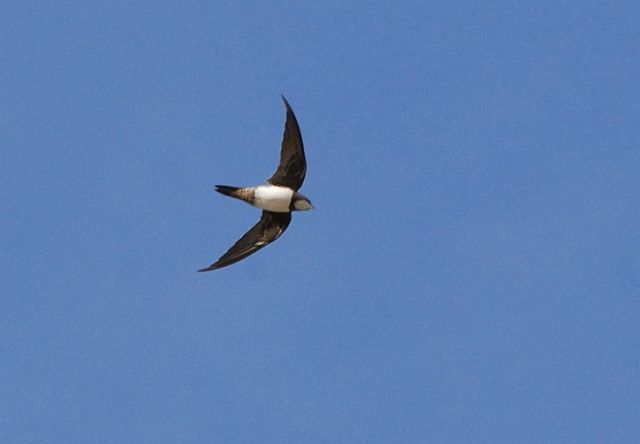
Links:
Species text Sabap1
Sabap2: http://sabap2.adu.org.za/spp_summary.ph ... §ion=3
Birds of Botswana
NEWMAN'S VOELS VAN SA (8ste UIT)
The Illustrated Encyclopedia Of European Birds
ARKive: http://www.arkive.org/alpine-swift/tachymarptis-melba/
ADW: http://animaldiversity.ummz.umich.edu/a ... tis_melba/

Links:
Species text Sabap1
Sabap2: http://sabap2.adu.org.za/spp_summary.ph ... §ion=3
Birds of Botswana
NEWMAN'S VOELS VAN SA (8ste UIT)
The Illustrated Encyclopedia Of European Birds
ARKive: http://www.arkive.org/alpine-swift/tachymarptis-melba/
ADW: http://animaldiversity.ummz.umich.edu/a ... tis_melba/
Common Swift
411. Common Swift (European Swift) Apus apus (Europese Windswael)
Order Apodiformes. Family: Apodidae
The Common Swift is special in many ways, the body is the perfect development for flying in the air. It does everything in the air, except breeding. It finds its prey there and feeds on the wing. It preens and plays in the air. It sleeps there most of the time. It mates and collects nesting material on the wing. It drinks while flying or takes showers when its bill dives and splashes water.
Description
16-18 cm. A medium sized Swift with long, scythe like wings and forked tail. It is blackish-brown except for a small white or pale grey patch on the chin.
Difficult to separate from Pallid and African Black Swifts, but Pallid Swift has a more well defined scalloped underpart pattern, whilst African Black Swift has more contrasting two-tone upper-parts. Common Swift averages paler on the throat than the other two species and in flight is slimmer looking with a more rakish appearance. Note that Pallid is a rare vagrant to S.A. therefore confusion more likely with African Black Swift where their ranges overlap. Common Swift seldom calls when in it's winter quarters.
Distribution
Much of Europe, Asia and Africa. A migratory species, it breeds at northern latitudes and travels to sub-Saharan Africa before the onset of the northern winter. Non-breeding grounds range over whole of sub-Saharan Africa. It occurs in patches across southern Africa.
Two subspecies of the common swift are recognised. Apus apus apus breeds across western and northern Europe, south-east towards Iran, and winters mainly from the Democratic Republic of Congo and Tanzania, south to Zimbabwe and Mozambique. Apus apus pekinensis breeds from Iran, east through the western Himalayas to Mongolia and northern China, and winters mainly in Namibia and Botswana.
Habitat
A wide range of habitats, prefers open, semi-arid areas.
Movements and migration
Palearctic non-breeding migrant, arriving in southern Africa in the period from October-November, leaving from January-March.
Diet
Common Swifts spend most of their lives in the air, living on the insects they catch in their beaks. It feeds exclusively on arthropods, especially insects, foraging at much higher altitudes than local-breeding swifts, often reaching heights of 1500-3000 m above ground. It usually flies at 36-90 km/hr, but it has been known to reach 216 km/hr in certain conditions! If it is cold and wet it descends lower, often feeding on termite alate emergences. It is its dependency on insects that explains why the common swift must migrate, as during the northern winter insects become scarce, whereas they are in abundance at this time in the tropics.
Diet
It feeds exclusively on arthropods, especially insects 2-12 mm long, foraging at much higher altitudes than local-breeding swifts, often reaching heights of 1500-3000 m above ground. It usually flies at 36-90 km/hr, but it has been known to reach 216 km/hr in certain conditions! If it is cold and wet it descends lower, often feeding on termite alate emergences. Interestingly, it is permanently airborne in its non-breeding grounds, roosting on the wing.
Breeding
It is faithful to its breeding place arriving around the 1st May in Central Europe. It's the last to arrive at its northern breeding grounds and the first to leave. The site of the nest is usually chosen by the male swift. They build their nests in all suitable hollows in buildings and also in holes of caves or hollows of trees. A swift will return to the same nesting site year after year, rebuilding its nest when necessary. The cup-shaped nest is made of feathers and vegetation glued together with saliva. A clutch of two or three eggs is laid in a Incubation duties are shared equally by the male and female and last for 19 or 20 days. Both adults feed the young for the 42 or so days that they are in the nest, with the adults flying as far as 560 miles each day whilst foraging
Young swifts in the nest can drop their body temperature and become torpid if bad weather prevents their parents from catching insects nearby. At the end of July the young will leave the nest. Around the 1st of August the parents will leave Central Europe for Africa.
Call
The call is a loud scream in two different tone pitches, of which the higher one is from the female and the lower one from the male. They often form 'screaming parties' during summer evenings where about 10-15 gather and fly around in circles calling. Listen to Bird Call.
Status
Common non-breeding Palearctic migrant.
Order Apodiformes. Family: Apodidae
The Common Swift is special in many ways, the body is the perfect development for flying in the air. It does everything in the air, except breeding. It finds its prey there and feeds on the wing. It preens and plays in the air. It sleeps there most of the time. It mates and collects nesting material on the wing. It drinks while flying or takes showers when its bill dives and splashes water.
Description
16-18 cm. A medium sized Swift with long, scythe like wings and forked tail. It is blackish-brown except for a small white or pale grey patch on the chin.
Difficult to separate from Pallid and African Black Swifts, but Pallid Swift has a more well defined scalloped underpart pattern, whilst African Black Swift has more contrasting two-tone upper-parts. Common Swift averages paler on the throat than the other two species and in flight is slimmer looking with a more rakish appearance. Note that Pallid is a rare vagrant to S.A. therefore confusion more likely with African Black Swift where their ranges overlap. Common Swift seldom calls when in it's winter quarters.
Distribution
Much of Europe, Asia and Africa. A migratory species, it breeds at northern latitudes and travels to sub-Saharan Africa before the onset of the northern winter. Non-breeding grounds range over whole of sub-Saharan Africa. It occurs in patches across southern Africa.
Two subspecies of the common swift are recognised. Apus apus apus breeds across western and northern Europe, south-east towards Iran, and winters mainly from the Democratic Republic of Congo and Tanzania, south to Zimbabwe and Mozambique. Apus apus pekinensis breeds from Iran, east through the western Himalayas to Mongolia and northern China, and winters mainly in Namibia and Botswana.
Habitat
A wide range of habitats, prefers open, semi-arid areas.
Movements and migration
Palearctic non-breeding migrant, arriving in southern Africa in the period from October-November, leaving from January-March.
Diet
Common Swifts spend most of their lives in the air, living on the insects they catch in their beaks. It feeds exclusively on arthropods, especially insects, foraging at much higher altitudes than local-breeding swifts, often reaching heights of 1500-3000 m above ground. It usually flies at 36-90 km/hr, but it has been known to reach 216 km/hr in certain conditions! If it is cold and wet it descends lower, often feeding on termite alate emergences. It is its dependency on insects that explains why the common swift must migrate, as during the northern winter insects become scarce, whereas they are in abundance at this time in the tropics.
Diet
It feeds exclusively on arthropods, especially insects 2-12 mm long, foraging at much higher altitudes than local-breeding swifts, often reaching heights of 1500-3000 m above ground. It usually flies at 36-90 km/hr, but it has been known to reach 216 km/hr in certain conditions! If it is cold and wet it descends lower, often feeding on termite alate emergences. Interestingly, it is permanently airborne in its non-breeding grounds, roosting on the wing.
Breeding
It is faithful to its breeding place arriving around the 1st May in Central Europe. It's the last to arrive at its northern breeding grounds and the first to leave. The site of the nest is usually chosen by the male swift. They build their nests in all suitable hollows in buildings and also in holes of caves or hollows of trees. A swift will return to the same nesting site year after year, rebuilding its nest when necessary. The cup-shaped nest is made of feathers and vegetation glued together with saliva. A clutch of two or three eggs is laid in a Incubation duties are shared equally by the male and female and last for 19 or 20 days. Both adults feed the young for the 42 or so days that they are in the nest, with the adults flying as far as 560 miles each day whilst foraging
Young swifts in the nest can drop their body temperature and become torpid if bad weather prevents their parents from catching insects nearby. At the end of July the young will leave the nest. Around the 1st of August the parents will leave Central Europe for Africa.
Call
The call is a loud scream in two different tone pitches, of which the higher one is from the female and the lower one from the male. They often form 'screaming parties' during summer evenings where about 10-15 gather and fly around in circles calling. Listen to Bird Call.
Status
Common non-breeding Palearctic migrant.
Dewi
What is the good of having a nice house without a decent planet to put it on? (H D Thoreau)
What is the good of having a nice house without a decent planet to put it on? (H D Thoreau)
Common Swift Photos
411. Common Swift (European Swift) Apus apus
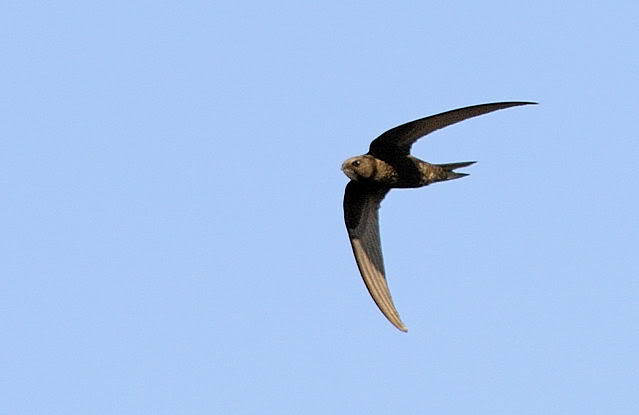
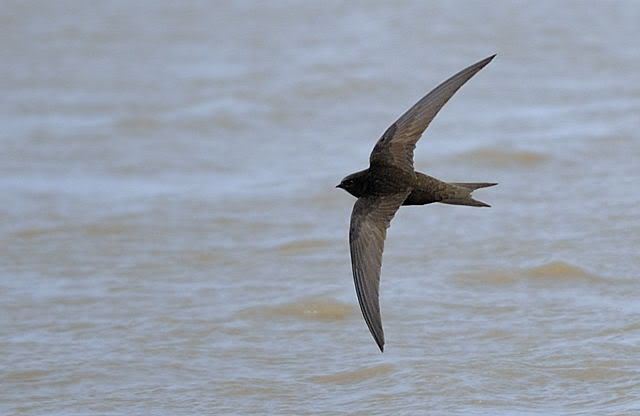
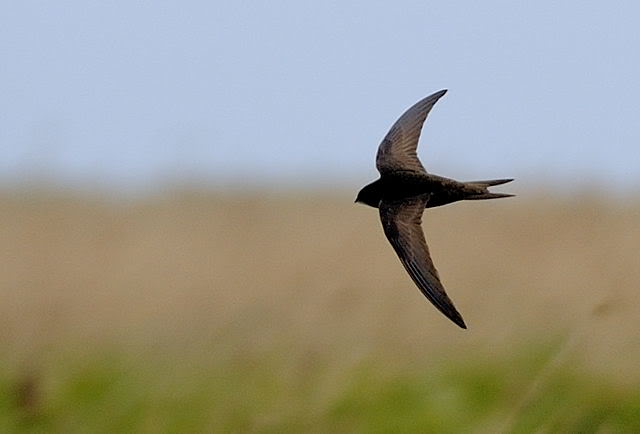
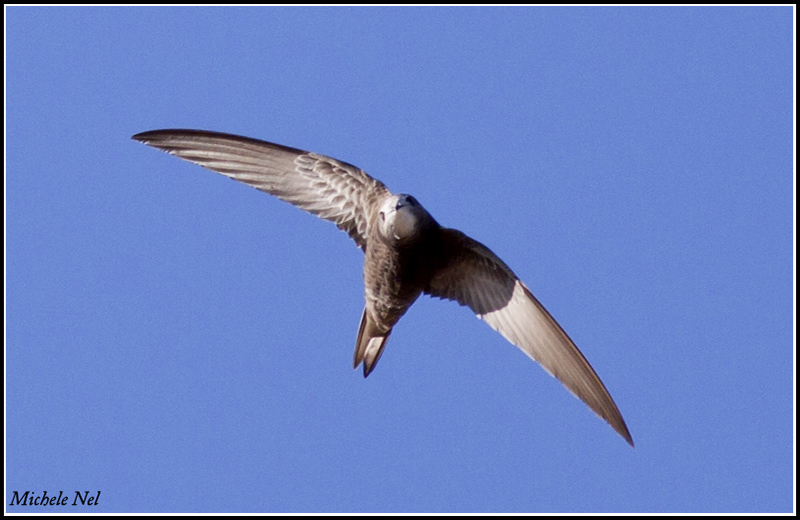 © Michele Nel
© Michele Nel
Kgalagadi Transfrontier Park, around Houmoed
Links:
Species text Sabap1
Sabap2
NEWMAN'S VOELS VAN SA (8ste UIT)



 © Michele Nel
© Michele NelKgalagadi Transfrontier Park, around Houmoed
Links:
Species text Sabap1
Sabap2
NEWMAN'S VOELS VAN SA (8ste UIT)
Dewi
What is the good of having a nice house without a decent planet to put it on? (H D Thoreau)
What is the good of having a nice house without a decent planet to put it on? (H D Thoreau)


